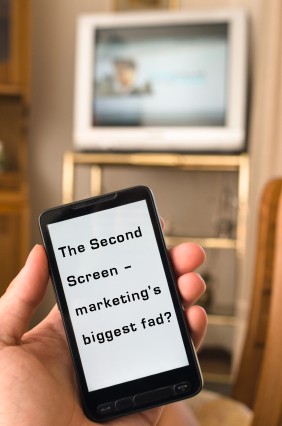There has been a lot of talk lately about the much vaunted ‘second screen’. It amazes me there can be so much discussion about engaging people through it, when many can’t even decide what ‘it’ is. Is it the TV, or is it the laptop/smartphone? For me, this question can’t get much simpler. The TV is a passive device. Apart from the brief and unsuccessful spell of encouraging viewers to press the red button during ad breaks, users of the device aren’t called ‘couch potatoes’ for nothing. Compare this to the interactive properties of a smartphone and the plethora of apps available, and you tell me which one is the second screen – the attention required to operate a smartphone is far higher than that needed to use a TV, and so if the two are used in conjunction the smartphone will naturally take precedence. Therefore it is the TV that is the second screen, plain and simple.
So what are marketers doing to take advantage of this phenomenon? The major usage appears to be driving online conversation through social networks. Look at programmes like TOWIE and X Factor, which always trend on Twitter whenever they’re broadcast. It certainly can’t be understated how this form of marketing drives success – TOWIE has become a cult programme and every single one of its stars (I use the term loosely) can be found in the tabloids daily. Pretty good marketing I would say.
But this form of communication isn’t applicable indiscriminately. Unless your product or brand has the clout (or money) behind it to gain TV coverage – advertising or otherwise – regularly, there really isn’t much opportunity for growth. Even if a product does achieve this, is utilising the two screens really going to be more effective than TV advertising, or social media, or online advertising? My gut reaction is no.
I believe exponents of the second screen have overlooked a growing technological innovation that could make such marketing practices redundant in the next few years. The growth of internet-enabled TVs from companies such as Samsung and Sony could easily consign the second screen to the dustbin of marketing quicker than you can say ‘yet another marketing fad’. Just take a quick look at the latest TVs to come out of CES 2012 – why would you use two screens when one will do? With drop down tabs and dual screen capabilities, these TVs allow browsing the internet while watch programming, all on the same screen. And as well this, you can place your social media feeds in columns to the side of the screen so you can keep track of friends conversations and trending topics without having to constantly switch your attention between screens.
While this technology remains at the top end of the price scale, I wouldn’t expect there to be a large uptake of it. But this is always the case, and as prices decrease I would put a good amount of money on this really being a game changer. Will we even need PCs anymore? Will computer programmes become incorporated into the household television? It really is the start of something that could fundamentally change how we consumer media of all types.






